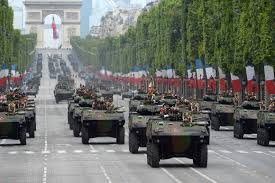Tomorrow, France is celebrating its famous national day or "le 14 juillet day". But do you know what are the origins? What do French do this day?
It began this way....
In 1789, the revolution started. Before that, the crises were everywhere: French people starved, havests were particulary bad, the unemployment increased, the state was financially ruined because they helped United States for their independance and it costed them a amount of money. Burgess wanted to share the equality with the nobility. During this time, the king Louis the XVIth didn't do anything. Deputies proposed to remove the absolute monarchy and to set a constitution. The king, of course, didn't agree. So the deputies of the "tiers d'état" (the third estate: it represents the great majority of people in France, it was composed of workers, landowner peasants, artisans, burgess) refused to split each other without changing the French government: it is '"le serment du jeu de paume" established the 20th of June 1989. Finally, the French monarque had to bow down. So, the deputies are allowed to write the constitution.The first National Assembly is born under the name of "l'assemblée constituante". But later, he regreated doing it.
What was going on? You know?
 |
| La Bastille |
We could imagine that king was irate so he decided to dismiss the Assembly. The deputies reacted and call for artisans and burgess to defend them. As the last one had no weapons, they decided to take some in a prison called "la Bastille". On the 14th of July, they attacked this prison and the event is "la prise de la Bastille". From this date, every year French people celebrate this event. After that, the Declaration of the Human rights and Citizen was proclaimed on the 26th of August 1789.
The celebration
It is bank holiday and the day is special.

In the morning, there is a military parade at "les Champs Elysées". Every year, the president invites a guest star, for example, it could be a squadron from abroad. All military Unit are represented : Unity on foot, Unity on horse, motorized and mechanized Unity and air Unit. This parade has been setting since 1790.
In every city, villages, the mayor, his/her councillors and some people living in the municipality go to the war memorial to lay a wreath. I remember when I was a child, I saw someone reading a list which were written the names of soldiers who died in wars (from the first world war and the followings) and for each name someone else said "death to France". The National anthem was sung. In Paris, in addition to lay a wreath at the war memorial, the President lays another one to the unknown soldier.
On afternoon, people have fun playing games (adults and children), for example they must guess how much does a big piece of ham weight. If someone is close to the right weight, this person wins it, the race stilts... They eat and drink. It is a good time to share. Meanwhile, the President gives a garden party at the Elysée. He invites famous and anonymous people.
On evening, everybody waits for the night to see the famous fireworks particulary children who are very impatient. It lasts about one hour. In general, it is free. After, some of them go to the dancing. It is organized by the municipality or by association, firemen...
This day is really a busy day even if it is bank holiday. Most of French love the National day.
